(AU)
P (yr)
(R
(M
(g/cm3)
P (days)
tilt
Tuesday, June 11th 2002. Reading: Cosmic Perspective Chapters 1 & 8
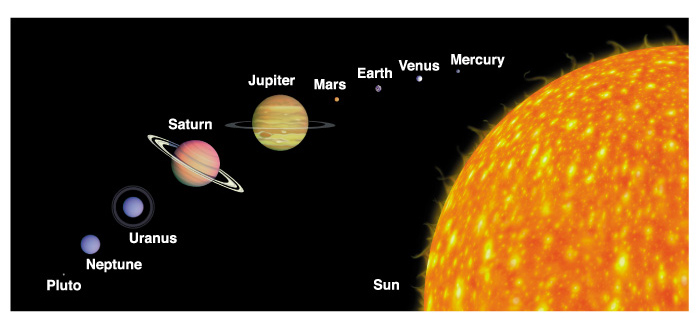
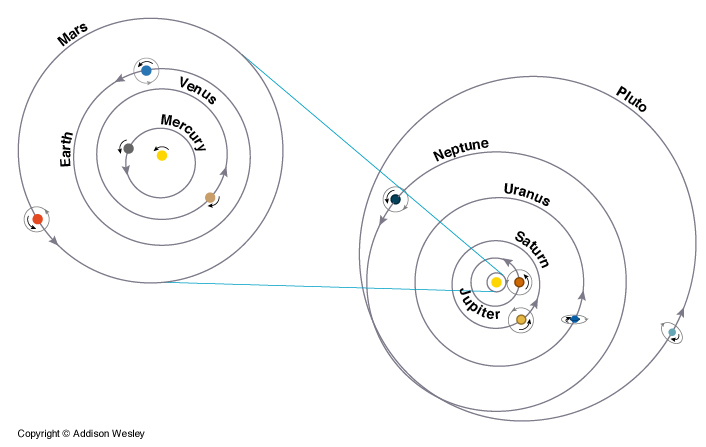
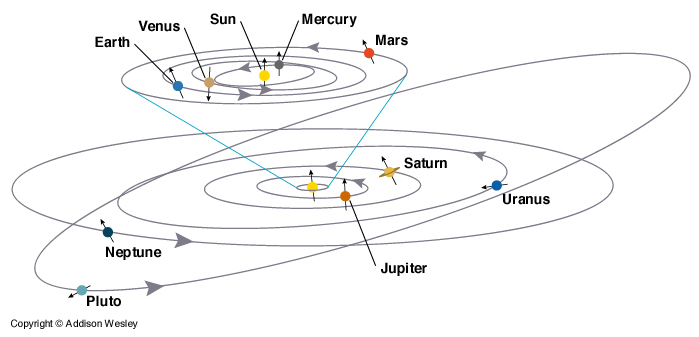
| Planet | dSun (AU) | Orbital P (yr) | Radius (R | Mass (M | Density (g/cm3) | Rotation P (days) | Axis tilt | moons | symbol |
| Mercury | 0.4 | 0.24 | 0.38 | 0.055 | 5.4 | 59 | 0.0° | 0 | |
| Venus | 0.7 | 0.62 | 0.95 | 0.82 | 5.2 | 243 | 177° | 0 | |
| Earth | 1.0 | 1.0 | 1.0 | 1.0 | 5.5 | 1.0 | 23.5° | 1 | |
| Mars | 1.5 | 1.88 | 0.53 | 0.11 | 3.9 | 1.03 | 25.2° | 2 |
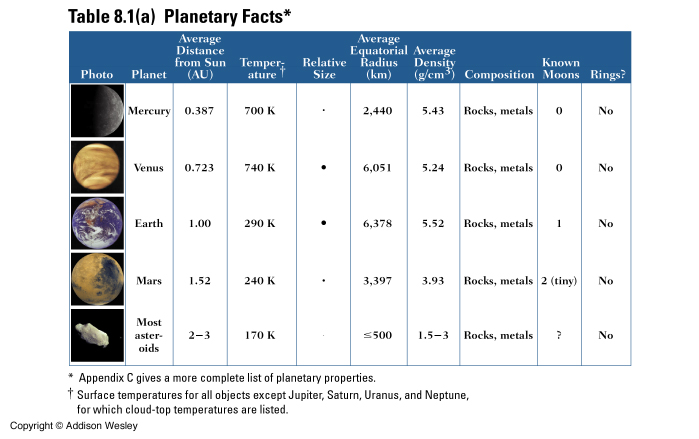
Difficult to study: always near the Sun in the sky. Sets or rises within 1 to 2 hours of the Sun -> blurred images since light is traveling through lots of atmosphere.
The rotation rate was finally measured with Radar. "Day and Night" cycle on Mercury = 176 days (88 consecutive days each of sunlight and darkness). The planet spins 3 times for every 2 orbits. Tidal friction brings the planet into synchronous rotation, but elliptical orbit keeps it from being 1:1. The orbital period is 88 days. Because of the orbit it is possible for the Sun to appear to move West to East for a brief period in the orbit.
Almost no atmosphere. Planet not massive enough to retain atmosphere, and too close to the Sun which heats gases to enough energy so that it can escape from the surface. Without an atmosphere to circulate heat around the surface the temperatures are very extreme. Daytime, T = 430°C. Night, T = -170°C
Mariner 10 (1974/5): flew past Mercury 3 times. Photos reveal the surface to be heavily cratered like the Moon. There are few if any uncratered Maria such as those on the Moon, however. There is no evidence for plate tectonics. Seems to be a geologically inactive world today. Not massive enough to generate sufficient heat in core, too small to retain any heat produced.
Interior structure inferred from density and mass. Mass measured by encounter of Mariner spacecraft with the planet. Recall that with Kepler's 3rd law one can measure the mass of planet by the orbital properties of a satellite.
Shrouded in highly reflective clouds: bright "evening (or morning) star". Also relatively close to the Sun in the sky. Clouds are composed of sulfuric acid.
Thick Atmosphere: (90 times Earth's surface pressure!)
96% CO2, < 4% N2 (Earth: 79% N2, 20% O2)
(Earth's CO2 is trapped in rocks and oceans)
Temperature of surface: 480°C! Hottest planet, due to runaway greenhouse effect.:
If there were an increase in the CO2 (or other greenhouse gases) in Earth's atmosphere, the surface would heat up -> release more CO2 into atmosphere -> runaway greenhouse
In 1990-1993 NASA's Magellan spacecraft orbited Venus taking detailed radar maps of the surface. 100m resolution! The spacecraft saw craters, volcanos, large plains, valleys. 2 large "continents" 2-3 km above plain, but crust consists of only 1 plate (thick crust). Planet is still geologically active!
Russian spacecraft, Venera, landed on Venus and was destroyed promptly by the corrosive atmosphere.
Has long retrograde spin period. Perhaps the result of a great collision with a large planetesimal in its early formation.
Red appearance due to rust (iron oxide). Surface visible through thin atmosphere. Clouds of ice particles visible in atmosphere. Mars has polar ice caps (mostly CO2) that grow and shrink with the seasons.
Thin atmosphere (1% Earth's): 90% CO2. Windy: major dust storms occur. Atmosphere thicker in the past -> more greenhouse effect -> warm enough for liquid water to exist on the surface. Some great catastrophe may have blasted away the atmosphere some 2-3 Billion years ago, or perhaps the atmosphere was slowly lost because the planet's surface gravity isn't strong enough to hold onto the thicker atmosphere.
T = -130°C to 30°C : generally cold.
Spacecraft (1960s - 1970s): saw craters, volcanos, canyons. No plate tectonics, planets seems geologically inactive. Amount of cratering indicates that erosion has not been at work for several billion years. Volcanic activity (Olympus Mons) may have continued up until 250 Million years ago, however. Volcanic activity rather light and does not help replenish the atmosphere.
No planet-wide magnetic field. So likley no molten rock in interior.
Ancient river beds! water was abundant long ago. Now it is believed to be frozen in a permafrost layer and in the polar ice caps.
Mars Pathfinder (1997) and Mars Global Surveyor: flood plains, dried up lake beds, morning fog in valleys, etc.
Two moons: Phobos and Deimos (Fear and Panic). Both irregular in shape because they are not massive enough to be self-gravitating. They are likley captured asteroids. They show some cratering. Phobos has cracks indicating that it was once struck so violently as to nearly break it in two.
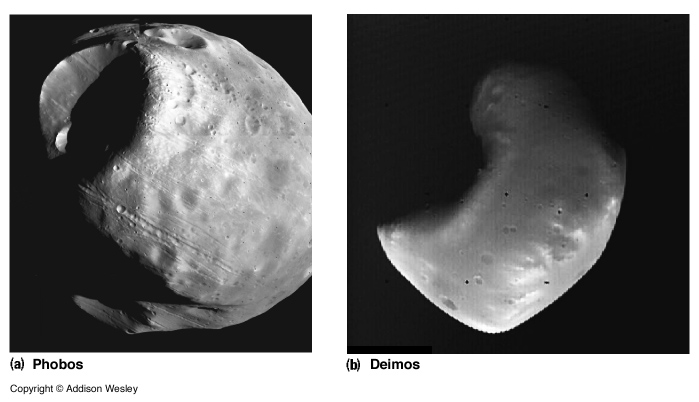
Life on Mars: Lowell's canals not real. 1976 Viking landers' tests were inconclusive. 1996: a meteorite from Mars is reported to have microscopic tube-like structures that look like fossilized tiny bacteria + several lines of chemical evidence. Very controversial.
Extraordinary Claims Require Extraordinary Evidence
| Planet | dSun (AU) | Orbital P (yr) | Radius (R | Mass (M | Density (g/cm3) | Rotation P (days) | Axis tilt | moons | symbol |
| Jupiter | 5.2 | 11.9 | 11.2 | 318 | 1.3 | 0.41 | 3.1° | 28 | |
| Saturn | 9.5 | 29.5 | 9.4 | 95.2 | 0.7 | 0.45 | 26.7° | 30 | |
| Uranus | 19.2 | 84.1 | 4.0 | 14.5 | 1.3 | 0.72 | 97.9° | 21 | |
| Neptune | 30.1 | 165 | 3.9 | 17.2 | 1.6 | 0.67 | 29.6° | 8 |
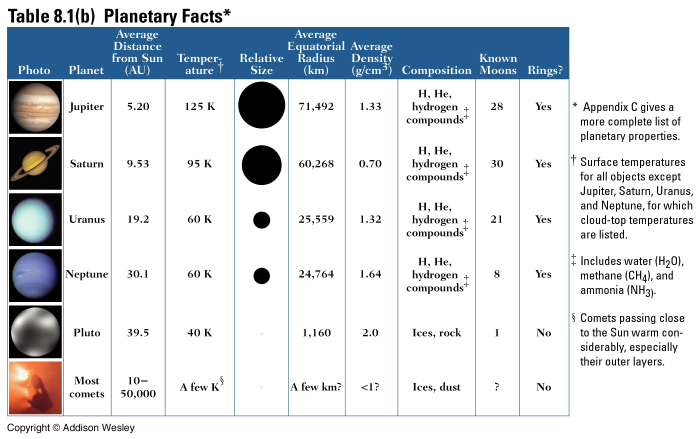
Its radius is 11 times Earth's (R![]() = 11R
= 11R![]() ), and one-tenth the size of the Sun (R
), and one-tenth the size of the Sun (R![]() = 0.1R
= 0.1R![]() ). Jupiter's mass is 320 times that of Earth (M
). Jupiter's mass is 320 times that of Earth (M![]() = 320M
= 320M![]() ) and one-thousandth that of the Sun (M
) and one-thousandth that of the Sun (M![]() = 10-3M
= 10-3M![]() ).
).
The planet is composed of mostly hydrogen and helium just like the Sun.
Colorful bands parallel to the Equator. Lot's of swirls, spots: stormy. One storm, the "Great Red Spot" is 2 times the size of Earth, and has lasted for at least 300 years (Galileo saw it in his telescope). It's a gigantic hurricane.
The planet appears oblate (squashed) this is due to rapid rotation (once every 10 hours!).
Planet has very thin rings seen for the first time by the Voyager spacecraft, they lie at a radius of 1.8R![]() . The spacecraft also witnessed lightening storms in the clouds.
. The spacecraft also witnessed lightening storms in the clouds.
Spacecraft visits: Voyager 1 and 2 (1979), and Galileo (1996/1997 - today). Beautiful close-up views of the planets and its moons.
The Galilean Satellites: the 4 largest moons of Jupiter each is larger than the Moon.
Saturn has a remarkably low density (0.7 g/cm3): it could float on an ocean of water!
Like Jupiter and the Sun it is mostly composed of Hydrogen and Helium, with an Earth-like core. It also has atmospheric bands of clouds like Jupiter, but they are less colorful.
It's most outstanding feature are its magnificent rings. The rings are mad of chunks of rock and ice. It is material that failed to coalesce into a moon, due to tidal forces of Saturn (inside the "Roche Limit"). The rings lie in the planet's equatorial plane (which is inclined 27°) to its orbital plane. This makes the rings appear "edge-on" twice per 29-year orbital period (e.g. in 1995). Only 4-5 of the rings are generally visible from Earth. There is a dark division between the 2 main rings ("Cassini's Division").
Spacecraft visits: Voyager 1 and 2 (1980): spectacular details! More than 100,000 "ringlets" only about 20 meters thick! Cassini spacecraft on its way...
Saturn has more than 20 moons (new ones being discovered all the time). The largest of the Moons (visible from Earth in a small telescope) is Titan. Titan has a thick Nitrogen atmosphere (like Earth!). It also has the same chemical in smog pervading its atmosphere. There is some greenhouse effect that helps warm it. It's possible that there are methane lakes and a rain of organic materials onto the surface. Life?
This planet was not known to the ancients. It lies at the threshold of the human eye's brightness detection limit. It was discovered in 1781 by William Hershal a musician and part-time astronomer.
It is smaller that Jupiter and Saturn, but still much larger than Earth. It is composed mostly of Hydrogen and Helium, plus some ammonia and methane clouds. The methane clouds absorb red light and reflect blue giving the planet its blue color.
Uranus is very cold: 60 K. Its axis of rotation is tipped by 98°! It almost lies in its orbital plane. Thus the planet has extreme season in terms of Sun variability.
Approximately 10 very narrow rings were discovered in 1977 when Uranus passed in from of a bright star (the light blinked out many times). The rings are very thin (less than 10 km wide). This is believed to be caused by "Shepard Moons".
Spacecraft: Voyager 2 (1986 - just a few days before the Space Shuttle Challenger disaster). It discovered the Shepard Moons around some rings, as predicted. They keep the rings narrow. The atmosphere of Uranus is remarkably featureless. The uneven heating is smoothed out.
The moon, Miranda, has quite an amazing surface. It's carved with grooves.
It is approximately the same size as Uranus (brother planets). It is also mostly composed of Hydrogen and Helium with some methane mixed in for good measure.
Neptune was discovered in 1846 (J. Galle), as a result of the analysis of Uranus' orbit: Neptune perturbs Uranus. In 1613 Galileo actually saw it and recorded it in his notebook, but he didn't realize what it was, he just thought it was a star.
Spacecraft: Voyager 2 (1989) made an approach within 5000 km of the planet! Discovered complete, but clumpy rings. Atmosphere much more dynamic than Uranus'. Winds up to 1,100 km/hr!. Many white and dark spots (storms). Wispy clouds of methane skirt around.
Magnetic field is tilted 50°, and offset from the center (like Uranus').
Triton: is Neptune's largest moon. It has a thin methane atmosphere. Fascinating and varied terrain. Dark plumes - active, icy volcanos! Fault blocks, collapsed basins, craters.
The end of Voyager's 12-years Odyssey...
Return to Class Notes Page